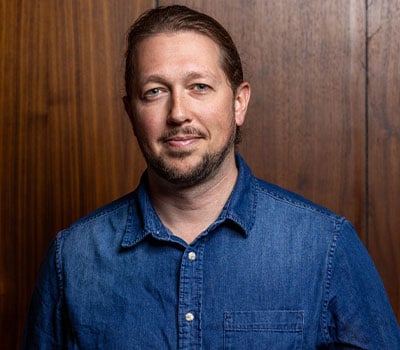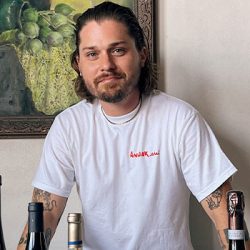Today, Ryan Kraemer is an Advanced Sommelier and a candidate with the Court of Master Sommeliers, but what originally drew him into the beverage industry was sake. He was working at a Thai restaurant in Nashville and, later, at Chicago’s Yusho where he joined the nihon-shu (sake) tasting group, If the Shu Fits. He eventually trained as a sommelier when he moved to Los Angeles and joined the team at 71Above as a server. Once he passed the CMS Certified Sommelier exam, Catherine Morel, the beverage director, gave him some shifts. Now he’s the Lead Sommelier and Wine Buyer for Majordōmo, in Los Angeles’s Chinatown, where the menu focuses on local ingredients fused in the melting pot of cultures that make up the city’s population—Japanese, Chinese, Korean, Hispanic… Kraemer calls it Chef David Chang’s love letter to “California, Los Angeles in particular.” —Alissa Bica


What wine regions are holding your attention right now?
I would say Champagne, Barolo and Northern Rhône are three that I find myself drawn to. I think that Champagne’s going to continue to get more nuanced with the explosion of grower producers, and how much more site-specific it’s becoming. It seems like every week, I’m learning about a new grower producer that everyone’s excited about. It starts to really matter what village they’re coming out of, and the vineyard names are going onto the bottlings. It’s getting more Burgundian. It’s also one of the more challenging regions to sell—to be able to speak to the differences and, hopefully, communicate that Champagne is more than just for celebration. It’s not start with a bottle of bubbles and then have some real wine with dinner: Champagne is a real wine and goes fantastic with the type of food that we have at Majordōmo.
I’ve recently brought in Hervieux-Dumez. He’s a member of The Special Club. His 2016 is finely edged, mineral, a cooler vintage. The ‘18 is a little bit more powerful and riper; the acidity isn’t quite as laser-like. I just I love this ‘16 for the freshness and mouthwatering characteristic, but also the depth, complexity and overall lovely, floral side of it.
Do you see the Burgundy model taking off in other places?
I find that same thing happening with Barolo and, for me, that’s exciting. It’s fun for me to think about how to buy Barolo and Barbaresco, finding the benchmarks but also finding the value in under-the-radar wines. Barolo is getting the MGA single site designations so, it’s also getting that kind of Burgundian rebuild, like Champagne is. It’s also one of the best wines with key dishes at Majordōmo, like the whole-plate short rib.
One of my favorite Barolos on the list is Bartolo Mascarello—we have the 2009 and the 2012. Mascarello is known for a traditional approach; they don’t do single-site expressions. It’s a blend of different sites throughout different communes, meant to be more of a complete picture. And they are pretty amazing. I think when you taste those classic old-school traditionalists with some age on them, they do show why they’ve stood the test of time and are so highly valued. As far as a more recent discovery that I brought in, it’s [Agricola] Brandini. Two sisters have taken over the family property, and they have really beautiful, elegant Barolos. I like the 2016 Cerretta—it has elegance and freshness but also a classic, savory, seductive Barolo profile. It’s a little more approachable—the bottle wholesales around 65 dollars.
What categories do you focus on for the restaurant?
Riesling is a big one for us. Our domestic and import chardonnay put together may rival riesling, but riesling is the longest category. I was fortunate to inherit a good inventory of Keller, from Rheinhessen. We have five on the list between $90 a bottle all the way up to $700. The 2021 Keller Limestone and the 2021 Trocken, the ones that are more in that $100 range, sell really well. Here, in a hipper restaurant, in a hipper part of town, people are open to dry riesling. I think it’s because they associate it with the style of cuisine. It’s a totally different story than when I was in Long Beach and you couldn’t give riesling away to some people.
Chenin blanc and grüner veltliner are two other varieties that also do really well with the food. The savoriness of grüner veltliner and that pepperiness is a good match for our food—there are so many powerful flavors on the menu, and so the wines need to have concentration in some element to stand up to the food. We have the [2022] Alzinger Smaragd from Mühlpoint Vineyard in Wachau. It’s fantastic. It tastes like radishes, white pepper, asparagus and Asian pears. And we pour a lot of our Veyder-Malberg Grüner Veltliner by-the-glass. It’s been one of my favorite discoveries in the last year.
The same thing with the chenin blanc. Its high acid and woolly texture and more autumnal stone-fruit flavors are big and bold enough that they’re going to go really well with a little-gem salad that has anchovy dressing, smoked trout roe and panko breadcrumbs. We pour a lot of Taille Aux Loups Clos Michet from Montlouis-sur-Loire. Jacky Blot was the winemaker; he passed away about a year ago. It’s one I’ve always loved. These wines all move probably because I’m preferential to them.
What wine trends have you noticed this past year?
A category that has just fallen off is rosé. I added maybe two or three wines and was thinking I under-doing it and then we hardly sold any. Skin-contact or orange wines have taken the share that rosé once enjoyed. I think orange wines are enjoying an outsized moment because they just keep it simple. If there are five whites and five reds [by-the-glass] on a menu, if you just go with the orange, you know what you’re going to get and don’t worry too much about if you’re going to like the style of chardonnay they’re pouring. It’s also trendy, and handcuffed to the natural wine movement. So orange wines sell—like our Jolie-Laide Trousseau Gris from Sonoma.
Also, chillable reds—Segni di Langa Nu. It’s a blend of his single-variety wines, nebbiolo, barbera and pinot nero. The wine is served in a liter bottle and is really delicious chilled. It’s not just punchy fruity, easy-drinking glou-glou. It does have some structure and a little savory Italian edge to it.
How do wine sales compare to cocktails?
For every 10 grand in liquor sales, we probably do around 70 to 80 percent of that in wine sales. This past year, wine sales decreased on the whole because it was a slower year than the year before, especially with the [writer and actor] strikes. But as a percentage of total sales, they increased.
Based in Los Angeles, California, Alissa Bica is the Associate Editor and Spirits Critic at Wine & Spirits. She is also a sommelier at 71 Above and co-runs the home wine tasting company, Côte Brune and Blonde. In any rare moments of free time, she writes about obscure grape varieties in the blog Off the Beaten Wine Path.
This is a W&S web exclusive. Get access to all of our feature stories by signing up today.



















